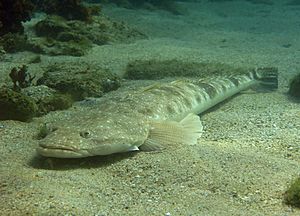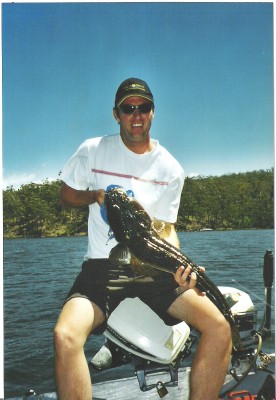Dusky flathead facts for kids
Quick facts for kids Dusky flathead |
|
|---|---|
 |
|
| Conservation status | |
|
Not evaluated (IUCN 3.1)
|
|
| Scientific classification | |
| Kingdom: | |
| Phylum: | |
| Class: | |
| Order: | |
| Family: | |
| Genus: |
Platycephalus
|
| Species: |
P. fuscus
|
| Binomial name | |
| Platycephalus fuscus G. Cuvier, 1829
|
|
The dusky flathead (Platycephalus fuscus) is a really cool fish! It's also called the black flathead. Its name means "flat-head dusky" in Ancient Greek, which makes sense when you see it. This fish is a big hunter and the largest in its family, the Platycephalidae.
You can find dusky flatheads mostly in estuaries, which are places where rivers meet the sea. They live in estuarine lakes and coastal bays along Australia's east coast. Their home stretches from Cairns in Queensland down to the Gippsland Lakes in Victoria. They like sandy, muddy, or gravelly areas, and even seagrass beds. They can live in salty water right up to where the tide stops.
How Does the Dusky Flathead Look?
Dusky flatheads have a very unusual body shape. This shape helps them hunt for food. Their body is wide but very flat, like it's been pressed down. Both of their eyes are on top of their flat head. This gives them great vision to spot prey swimming above them.
They look a bit like a flounder, but flatheads are much longer. Their tail stays upright, and they have a big, wide mouth. Flatheads use their flat bodies to hide in the sand. They can even change their body color to match their surroundings! Only their eyes stick out. When a small fish or prawn swims by, the hidden flathead suddenly bursts out to catch it.
The dusky flathead has a special feature to help you tell it apart from other flathead fish. Look for a row of small brown spots on its pectoral fins (the fins on its sides).
Where Do Dusky Flatheads Live and What Do They Eat?
Dusky flatheads are the biggest and most commonly caught type of flathead in Australia. They can grow very large, sometimes up to 1.3 meters long and weighing 12–15 kilograms! However, most dusky flatheads caught are about 40–50 centimeters long and weigh 0.5–1.5 kilograms.
These fish usually live in estuaries and estuarine lakes. You won't often find them in other places. Their main diet includes smaller fish and prawns.
Scientists used to think that dusky flatheads changed their sex from male to female as they grew. However, newer studies suggest that their sex is decided when they are young fish. It's true that only the female fish grow to the largest sizes. Dusky flatheads usually breed in the middle to late summer, near the mouths of estuaries.
Fishing for Dusky Flatheads
Dusky flatheads are very popular for both commercial fishing and for people who fish for fun in eastern Australia. They are easy to catch using bait or minnow lures. When hooked, they put up a good fight! Recently, people have found that soft plastic lures are also very effective for catching them.
Because so many people like to fish for them, it's important to protect dusky flathead numbers. Many anglers now practice "catch and release." This means they let the fish go after catching it. This helps keep enough fish in the water for the future.
Many fishermen used to believe that releasing very large flatheads (over 70 centimeters) was important. They thought these big fish were important breeding females. However, studies show that most of the eggs come from medium-sized females (50–60 centimeters). Also, very large females (over 70–75 centimeters) often have eggs that are not healthy and won't be laid. So, while catch and release is good, it's the medium-sized females that are most important for making new fish.


